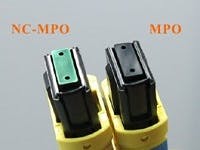Two types of high-density fiber-optic connectors are currently popular: the traditional MPO and the MXC series. Traditional MPO connectors require all fiber end faces to be in close physical contact at the same time. To achieve this goal, the fiber end face must protrude from the surrounding surface, and a large working pressure is required on the optical fiber connector. The MXC connector, meanwhile, uses microlenses to expand the light beam, which avoids the direct contact of the fiber end face and the requirement for all the optical fibers to be connected at the same time. However, due to the introduction of more elements in the optical path, MXC connectors suffer from greater complexity and cost, as well as reduced reliability and optical performance.
Non-contact MPO fiber connectors are coated with an anti-reflective (AR) coating on the fiber end face. All fiber ends remain below the connector ferrule surface. The AR prevents light from multiple reflections, while the recessed fiber end face ensures no damage to the fiber end face in mating. When the connectors are mated, there is a small air gap between the end faces of the fiber that does not affect performance.Non-Contact MPO connectors offer a superior alternative that works equally well for singlemode and multimode fibers.
Judge's comment: An interesting alternative to traditional MPO and MXC connectors, this non-contact MPO connector offers exceptionally low insertion loss with good repeatability thanks to its anti-reflection coating and built-in air gap.
Click here to return to the 2017 Lightwave Innovation Reviews page.
Sponsored Recommendations
Sponsored Recommendations
March 10, 2025
Sept. 30, 2024

